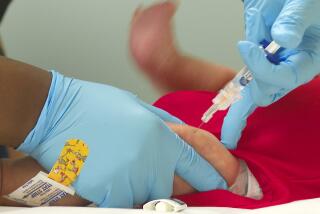Pneumonia Spreads Among Infants : Medicine: This winter, 271 babies with the viral infection have been admitted to Children’s Hospital, compared to 194 last season. Two have died since Saturday.
- Share via
ORANGE — An unusually large outbreak of a potentially deadly viral pneumonia in Southern California this winter is proving especially dangerous to babies, according to physicians at Children’s Hospital of Orange County.
The illness, known as respiratory syncytial viral pneumonia, killed a 2-month-old girl Wednesday who had been admitted to CHOC, said Dr. Gary Goodman, associate director of the pediatric intensive-care unit. Another infant, a 2-month-old boy, died Saturday from the ailment at the hospital, he said.
Currently, 13 of the 23 infants in the pediatric intensive-care unit in Orange are being treated for the life-threatening viral infection, CHOC physicians said. More than half of the babies at the CHOC-operated pediatric hospital in Mission Viejo have the pneumonia.
Last winter, 194 babies were admitted to CHOC with the illness, compared to 271 so far this winter.
“Southern California is being hit harder with this virus than other parts of the state--and country for that matter,” Dr. Nick Anas, director of the pediatric intensive-care unit at CHOC, said in a prepared statement.
“At the rate we are going, we’ll reach the same numbers as the ‘91-92 season, which was an epidemic season in Orange County,” Anas said.
Two winters ago, Goodman said, 367 babies were hospitalized at CHOC with the pneumonia, and it remains to be seen whether this season will match that number.
“It is not over yet,” Goodman said, noting that each year the virus surfaces between November and April, although December through February tend to be the peak months.
Goodman said the illness is a “highly contagious” virus for which there is no immunization. It begins with a runny nose and low-grade fever, he said, and can progress to coughing and wheezing.
While adults also can get the virus, she said, it is more serious in infants because their lungs and airways are smaller and their breathing muscles are not as strong.
Goodman said that for every baby whose symptoms are serious enough to warrant hospitalization, there are 100 infants in the community also suffering from the illness.
“Usually they are brought to the hospital when their breathing is labored and they are no longer able to eat or drink anymore,” he said. In the hospital, he said, the babies receive intravenous fluids and are put on ventilators. Some of the most critically ill babies, he said, are treated with newer techniques such as high-frequency ventilation or are placed on heart-lung bypass machines.
It is important for parents to seek medical care for infants who show symptoms, Goodman said.
“If infants under a year have respiratory problems, they need to see a doctor, he said, “particularly those born prematurely or those with heart problems and lung problems or where something is wrong with their immune system.”
More to Read
Sign up for Essential California
The most important California stories and recommendations in your inbox every morning.
You may occasionally receive promotional content from the Los Angeles Times.










